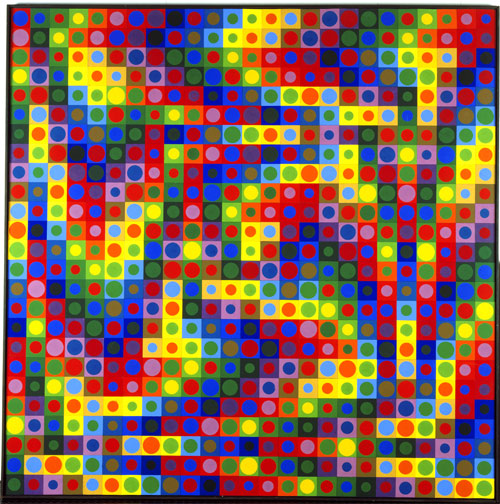Scan barcode
A review by glenncolerussell
Vasarely by Gaston Diehl
5.0

This handsome coffee table book by Gaston Diehl on the art and life of Hungarian-French artist Victor Vasarely (1906-1997) is a real find. The quality of seventy Vasarely prints (nearly all displayed on a full page and in color) is excellent. Also, art historian Gaston Diehl provides an insightful twenty-page overview of Vasarely's artistic evolution from a successful graphic artist in his twenties, an artist who, to use Vasarely's own words, went down the wrong track by producing works in the styles of the day - cubism, expressionism, futurism, symbolism, surrealism - until age forty, the time when he found his true creative self and hit his visual stride in geometric abstract art, or, what has come to be known as Op Art. Victor Vasarely also became a pioneer in the field of Kinetic Art.
Diehl provides detail of how the artist developed a unique geometric style over many years of trial and error. We read: "To accomplish harmonious compositions and unique constructive solutions, he constantly attempts to situate forms and colors on the plane surface; to purify both in order to obtain an economy of means and a total simplification, which are not however an impoverishment, as he emphasizes in his reflections; and lastly, to organize a rhythmic, balanced concatenation which suggests both a different space and a movement in gestation."
From my own experience, this is what I see when looking at Vasarely's geometrical shapes: purity and rhythm and balance as the clear forms and vivid colors seem to play with one another; it is as if I am transported to a completely free, completely open, non-temporal visual realm. If this sounds mystical, there’s good reason, it is mystical. As Diehl explains, Valarely engaged in "transformation of the external vision into an internal vision".
Here is another quote from Diehl underscoring the transcendent quality of Vasarely's geometric art: "The subtle dislocations arranged, and the numerous sharp angles, give the composition an appearance that is intermediate between pure spirituality and nature; that is: they lead to a geometry made all the more vivid by the fact that the force of the contrasts emphasizes its radiating luminosity."
I recall viewing an exhibition of Vasarely art and sculpture at the Philadelphia Museum of Art some years back. I didn't want to leave. The combinations of colors and forms were so powerful and magnetic my eyes couldn't get enough Here are my brief comments on works from two prints in the book:
VEGA-WA-3
We have the geometry of circles, twenty-three circles on the vertical and twenty-two on the horizontal for a total of five-hundred-and-six circles, but these circles are not simply static, rather, the circles bulge out at the center, as if the vinyl canvas is a flexible rubber sheet and a ball is being pushed from the rear toward the viewer creating the illusion of three-dimensionality. The circles on the left are black on a burnt orange background and the circles on the right are light gray on a black background and as the shapes change via the pushed ball so the color of both the circles and background change into one another - a unique metamorphosis, the cross-transformation of both color and form.
TAYMIR
A study in black-and-white, the artist has rectangles, triangles, parallelograms and squares overlapping one another in dazzling combinations, the overlap changing the shapes from white to black and from black to white or enlarging or shrinking the black-and-white design. Many of the squares are actually diamonds, standing on one of their corners. How many overlaps and combinations? Dozens and dozens and dozens. If you enjoy art of this type, you will find something new and fascinating with every viewing.

I don't know if I will ever have the opportunity to go to one of the Victor Vasarely museums in France or Hungary, but meanwhile there are a number of excellent books, including this one published by Crown Art Library.
Just for the fun of it, more art from this spectacular artist:



